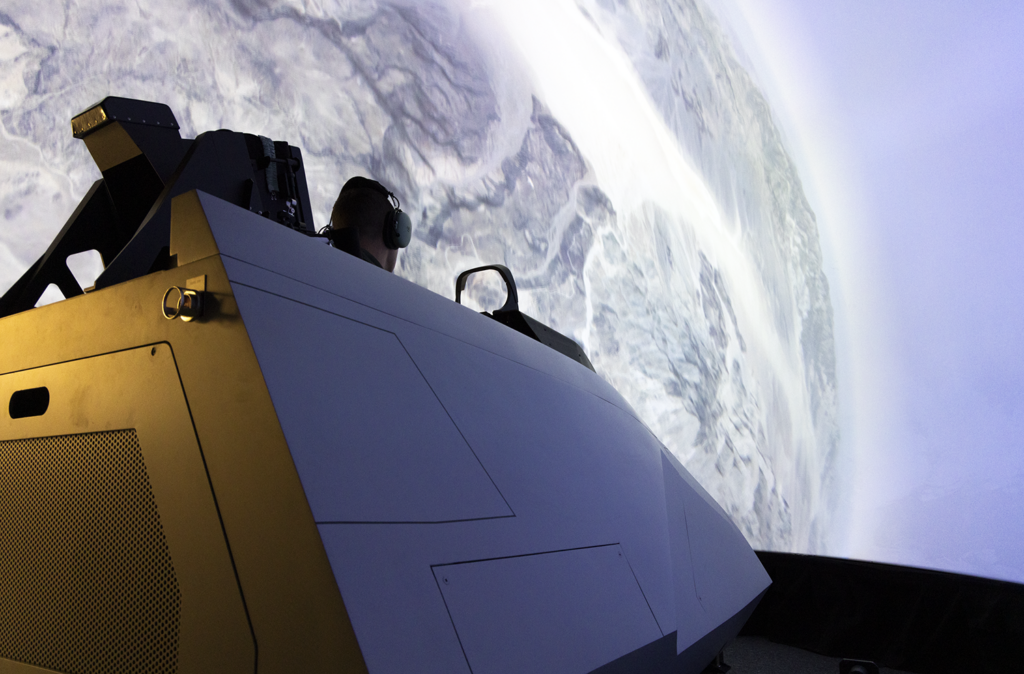
Naval Air Warfare Center Aircraft Division, Apr. 2, 2024
PATUXENT RIVER, Md. — Navy and Air Force fighter pilots will begin training as a joint force at the Naval Air Warfare Center Aircraft Division (NAWCAD)’s Joint Simulation Environment (JSE) starting in 2024.
NAWCAD installed a division of four U.S. Air Force F-22 Raptor cockpits into the Navy’s premier simulation test and training facility alongside its division of eight F-35 Lightning cockpits in January.
“When America is engaged in conflict, the DOD will bring joint capability to bear from every service across all domains,” said NAWCAD Commander Rear Adm. John Dougherty IV. “We’ve replicated this ability in the Joint Simulation Environment, a force multiplier helping aviators deter aggression and—if necessary—prevail in conflict.”
The new addition of fifth-generation fighter simulators brings Navy, Marine Corps, Air Force, and allied partners into the hyper-realistic digital range that consists of cockpits, domed simulators with 4K projectors, and aircraft software to enable pilots to fly wartime scenarios in a near-exact virtual environment. Tactical groups training in NAWCAD’s JSE fly more sorties over one week than they do over a year on open-air ranges.
“Open-air ranges are extremely constrained with safety limitations that prevent warfighters from training like they’d fight,” said NAWCAD JSE Director Blaine Summers. “The JSE is where fifth-gen fighters train to hone their tactics and fight like their lives depend on it.”
Developed by Navy engineers and industry partners, NAWCAD’s JSE is a powerful training and test facility designed to adapt and grow, utilizing hardware and software from actual DOD aircraft, weapons, and other defense systems. The JSE has all the equipment and experts needed to keep the facility running smoothly from its cockpits, to its software and simulators, to its mission debriefing rooms where pilots get feedback on their performance during training.
In this highly realistic digital range, aviators experience the consequences of their mistakes, including mission failure, loss of systems, and even loss of life. The JSE enables pilots to learn those hard lessons, immediately adjust, fly again, and continue the learning process to become a highly capable tactical aviator.
The JSE was initially designed to support F-35 Lightning’s operational testing as there was no way to safely and adequately represent real-world conflict on an open-air range. Today, the DOD is scaling the Navy’s technology for additional digital range facilities supporting programs like F-35, F-22, and E-2D. In addition, the DOD has made training in the JSE a formal part of the Navy’s Strike Fighter Tactics Instructor Program—commonly known as TOPGUN.
Over the next year, NAWCAD will incorporate additional test and training cockpits including the F/A-18 Hornet, EA-18 Growler, and E-2 platforms to train fighters for future flight lines. The warfare center will also deploy its second training system onboard a Navy carrier, USS Abraham Lincoln (CVN 72).
The Naval Air Warfare Center Aircraft Division employs more than 17,000 military, civilian and contract personnel. It operates test ranges, laboratories and aircraft in support of test, evaluation, research, development and sustainment of everything flown by the Navy and Marine Corps. Based in Patuxent River, Maryland, the command also has major sites in St. Inigoes, Maryland, Lakehurst, New Jersey, and Orlando, Florida.



